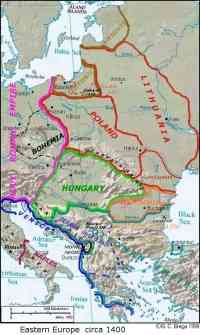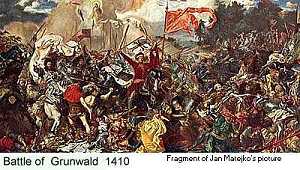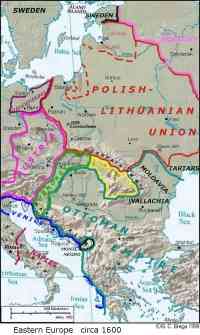 |
Two Thousand Years of the Modern Era in Eastern Europe Part 3: 14th to 16th Centuries - Turkish Advances. |
Bill Biega's History Essays |
|
Biega Home Page
Consulting Using special characters. East Europe Cities, Countries, Info. History Genealogy, History Essays Maps Cities, Countries, Historical Photo Gallery Places I visited Rydzyna Sailing all over the world Syrena Press 13 Is My Lucky Number Learning LINUX 
Contact us by Email |
Click on any illustration with colored border to see it full size. Then click on "Back" button to return to this page.
For Poland a period of increasing strength commenced with the reign of the last Piast, Casimir the Great. He unified the kingdom, increased it with the annexation of Galicia and Podolia in the east and by treaties with Hungary and Brandenburg. Even more important were the laws guaranteeing tolerance of religion and autonomy for the increasingly important towns. These assured an influx of German and Jewish artisans and traders and saved Poland from religious strife during the spread of the Protestant Reformation. The privileges granted to landowners provided the means for electing future kings. In 1364 the second university of Eastern Europe was founded in Cracow. One of its later students, Copernicus, developed the revolutionary idea that the earth revolved around the sun (1514).
In the south, the Ottoman armies were engulfing what remained of Byzantium. The Serbian king Stefan Dusan enlarged Serbia in the early 1300's to include all of Macedonia and northern Greece, but upon his death the kingdom collapsed under Ottoman pressure. Sultan Murad's armies destroyed the Serbs at Kosowe Polje in 1389. Sultan Murad I was also killed in the battle. Bulgaria was occupied about the same time. Constantinople was surrounded but, thanks to the network of fortresses, the ability to obtain supplies by sea and the underground water reservoirs, was able to hold out until 1453.
In the 15th. and 16th. centuries Hungary suffered from a serious decline due to internal fights between the increasingly powerful nobles. They elected weak kings and declined to pay the taxes needed for a strong army to defend the country from invasion. A brief respite was provided by the succesful defense, in 1456, of Belgrade by Janos Hunyadi, a general from Transylvania, and the election of his son Matthias as king. Upon his death, the nobles again elected weak figureheads. When Suleiman the Magnificent resumed the Ottoman attack in 1526, a small Hungarian army lead by 20 year old Louis II (of the Jagiellon family) was soundly defeated at Mohacs and Louis died. Suleiman went on to besiege Vienna in 1529 but then retreated when paid off with a large ransom. Hungary was split into three parts - Royal Hungary, a narrow sliver of land ruled by the Austrian Habsburgs - Turkish Hungary, including the city of Buda - Transylvania in the mountains. Transylvania maintained its independence as a vassal state paying taxes to the Ottomans. It was ruled by local princes, the towns, inhabited by Saxon (German) settlers, prospered from trade between Christian and Moslem Europe.
As the 16th. century drew to a close, Eastern Europe was dominated by two super powers - Poland in the north and the Ottoman empire in the south.
As in Hungary, the nobles were increasing their strength and independence in Poland. Under Sigismund (Zygmunt) II August, the
Lublin Union of 1569 effectively created the Republic of Poland, uniting the two realms of Poland and Lithuania, and granted the gentry effective control over the country through the parliament (Seym). The king was required to convene the Seym every two years and in between had to consult with the Senate. Thus a constitutional kingdom was established, preceding that of England by half a century. It was also a new democracy, the first since the decline of Athens two thousand years earlier. True, only the landed gentry and the bishops had a voice, but universal suffrage would not appear until 200 years later after the French revolution, and then only briefly.
In the West, Queen Elizabeth ruled England; the religious wars were just starting in France; the Inquisition was in full swing in Spain; the colonies in America were just in their infancy. This brief summary does little justice to the complex history of three hundred years. Please follow up on the many links to learn more.
Return to Top of page. Return to History Table of Contents for other History Essays. |
|
Return to Home Page.
Last update May 2002 |



